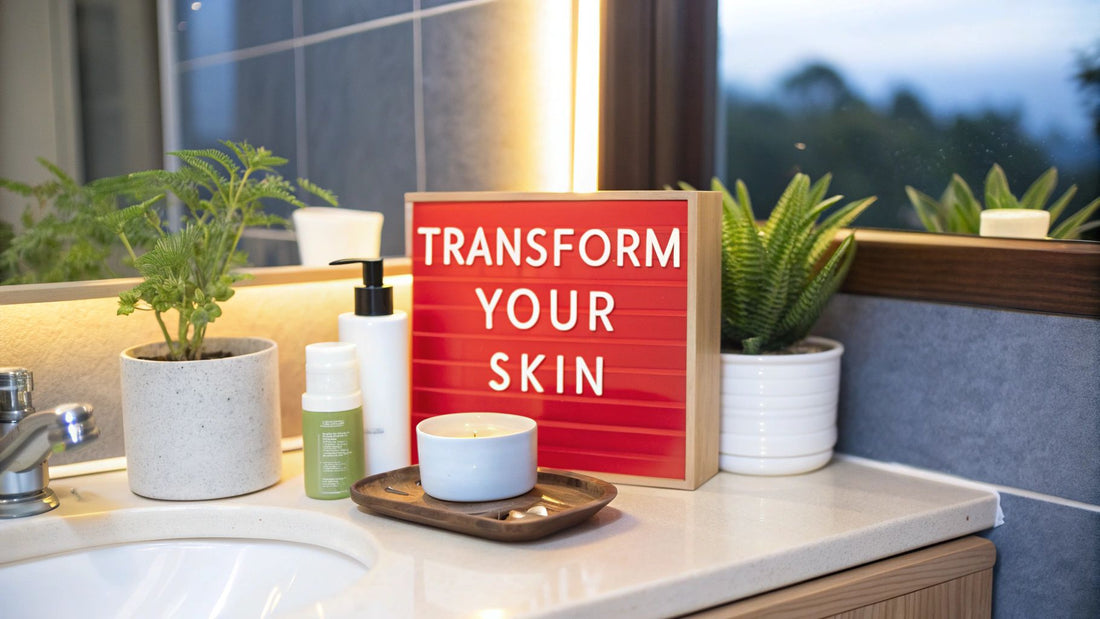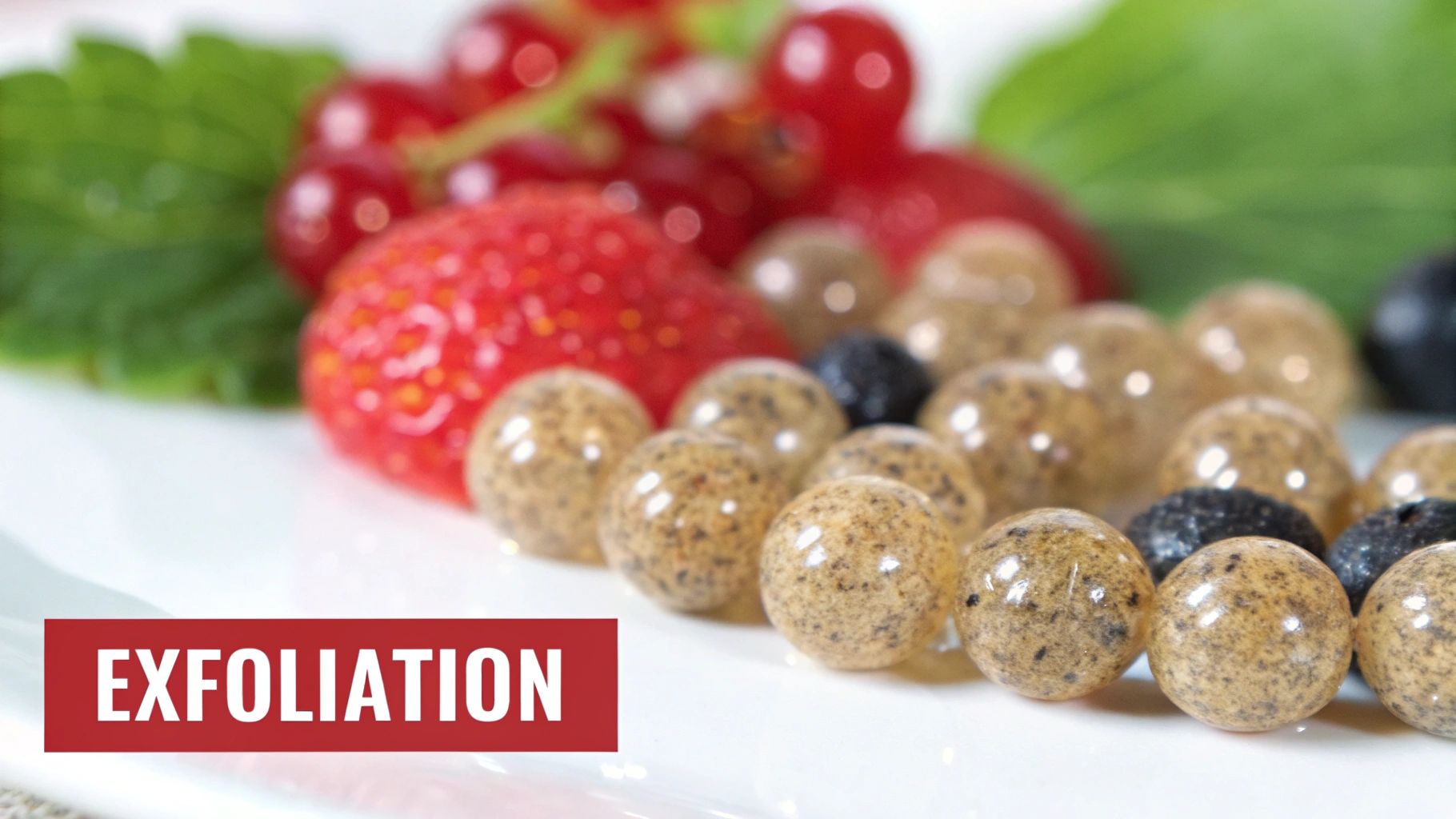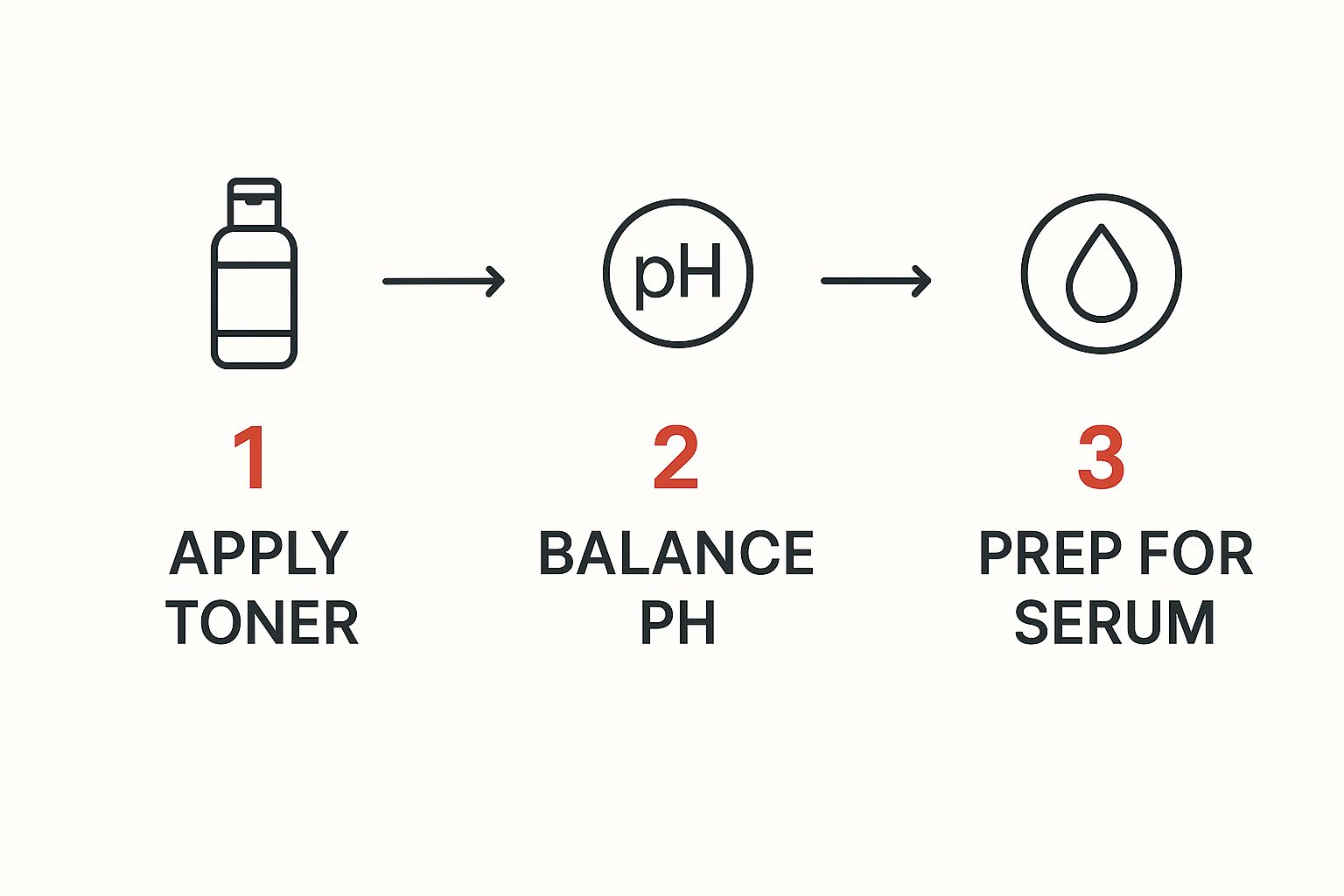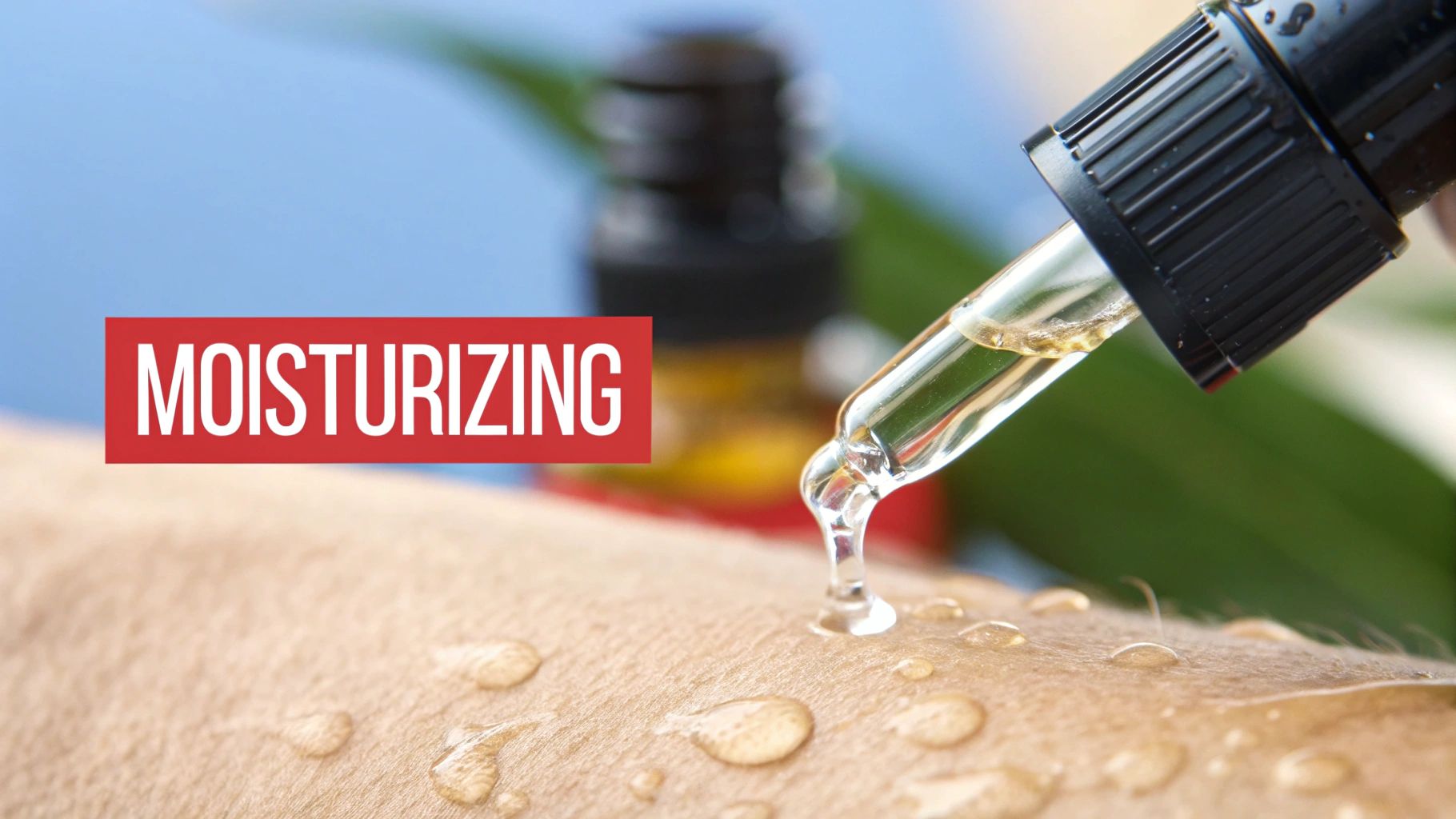
Skincare Routine Steps That Actually Transform Your Skin
Share
Why Your Current Skincare Routine Steps Aren't Working

Does this sound familiar? You’ve invested time and money into a cabinet full of promising products, you follow the instructions to the letter, but that radiant, healthy skin you’re aiming for just doesn’t seem to appear. It's frustrating, and it’s easy to blame the products, but often the real problem is something most of us don't even consider: the sequence of application. The order of your skincare routine steps isn't just a friendly suggestion; it’s the secret to making your products actually work.
Imagine you're tending to a garden. You wouldn't throw down a thick layer of mulch before planting the seeds, right? The same logic applies to your skin. If you apply a rich, heavy moisturiser before a lightweight, water-based serum, you’ve essentially created a barrier that stops the serum’s active ingredients from getting where they need to go. Your skin is designed to keep things out, so to get the good stuff in, you have to layer products from the thinnest to the thickest consistency.
The Science of Layering and Absorption
Your skin can only absorb so much. When you slather on a heavy cream first, its larger molecules sit on the surface and form a seal. This means any lighter products you apply afterwards, like toners and serums that need to penetrate deeper, are blocked. That expensive serum you bought? It might just be sitting on top of your moisturiser, its benefits going completely to waste.
This is a really common reason people feel their routine is failing. They might have brilliant products but are using them in an order that makes them ineffective. For example, if you have oily skin and apply a mattifying serum over your SPF, neither product can do its job properly. By simply swapping the order, you allow the serum to treat your skin directly before the sunscreen provides its protective layer. It’s a small change, but it can be the difference between disappointment and seeing real results.
The Consistency Conundrum
Beyond the order of application, the next hurdle is consistency. It’s one thing to have the perfect routine on paper, but it’s another to stick with it day in and day out. This isn't just a feeling; a recent UK survey revealed that 60% of Brits struggle to maintain a consistent skincare routine. Your skin needs regular, predictable exposure to beneficial ingredients to truly show improvement. You can read more about this common challenge in the full survey on skincare habits in the UK.
Of course, the products themselves matter immensely. It’s so important to choose formulas that support your skin barrier without causing irritation, which is why mindful, gentle products are gaining so much popularity. To help you build a routine that is both safe for you and the planet, you can check out our guide on non-toxic skincare. When you combine the correct sequence with consistent, daily application, you create the ideal conditions for your skin to truly flourish.
Morning Skincare Routine Steps That Fit Real Life

Let's be honest, your morning routine doesn't need to be a complicated, 10-step saga that makes your bathroom counter look like a cosmetics shop exploded. What you see on social media can be overwhelming, but for most of us, an effective morning starts with a simple, focused approach. The mission is clear: cleanse, treat, and protect. It's all about mastering the essentials to get your skin ready for the day, whether you have five minutes before the school run or a more relaxed fifteen to yourself.
The idea that more products mean better skin is a myth that needs busting. In reality, many people discover that simplifying their skincare routine steps leads to calmer, happier skin. Picture this: a busy professional doesn't have time for a dozen different bottles. They need a gentle cleanser, a hard-working serum, and a solid SPF. A parent juggling work and family might just go for a hydrating mist followed by a moisturiser with built-in sun protection. The real trick is choosing products that pack a punch with minimal fuss, focusing on what your skin actually needs.
The Non-Negotiable Morning Trio
The secret to a routine you’ll actually stick to is building it around a solid foundation. You can always add extra steps when you have time, but these three are the bedrock for protected, healthy-looking skin.
- A Gentle Cleanse (or Even a Skip): For many people, especially if you have dry or balanced skin, a simple splash of lukewarm water or a quick swipe with a reusable pad soaked in micellar water is plenty. If you have oily skin or wake up feeling a bit greasy, a mild, non-stripping vegan cleanser is your best friend. The goal here isn’t a deep, squeaky-clean feel; it’s just about creating a fresh canvas for the day.
- Targeted Treatment with a Serum: This is where you get to address your specific skin concerns. A vitamin C serum is a fantastic choice for the morning, as it’s a powerful antioxidant that helps shield your skin from environmental stressors and brightens your complexion. If your main goal is a big drink of water for your skin, a hyaluronic acid serum is perfect. Always apply it to slightly damp skin to really seal in that moisture.
- Essential Protection with SPF: If you only do one thing, make it this. Sunscreen is your daily shield against premature ageing and skin damage, making it the most critical of all the morning skincare routine steps. Look for a broad-spectrum, cruelty-free SPF of 30 or higher and be generous with it. This should always be your final step before any makeup.
This simplified approach doesn't just save you precious minutes; it encourages consistency, which is what truly delivers results. How much time people spend can vary widely. For instance, Gen Z adults in the UK spend an average of 20 minutes on their daily routine, more than any other generation. You can read more about these skincare generational trends in the UK. But remember, a quick, consistent routine will always outperform a long, occasional one. Building a morning ritual that genuinely fits into your life is the true key to success.
Evening Skincare Routine Steps for Skin Recovery
When the sun sets, your skin’s focus shifts from protection to repair. This is your chance to support its natural recovery process, but it's also where routines can get a bit muddled. Good evening skincare routine steps aren't about layering on a dozen products; they’re about choosing the right ones and applying them smartly to wash away the day and welcome regeneration.
A common mistake is thinking you need a really harsh cleanse at night. Unless you're wearing heavy, long-wear makeup, a single, thorough cleanse with a gentle, oil-based or creamy vegan cleanser is usually all it takes to dissolve grime, SPF, and pollutants without stripping your skin's protective barrier. This preps your skin for the important treatment steps that come next, making sure they can work their magic while you sleep.
The Power of pH Balance and Serums
What you do right after cleansing is key to getting the most out of your treatment products. Many people skip toner, seeing it as an old-fashioned step, but a modern, hydrating toner does much more than just feel nice. It really sets the stage for everything else.
Toning prepares your skin to absorb products much more effectively. This infographic shows you how it all fits together.

As you can see, applying a toner helps balance your skin's pH and adds a fresh layer of hydration. This simple action helps your serum penetrate more deeply, which can make a noticeable difference in your results over time.
To help you visualise how your morning and evening routines differ, here’s a quick comparison of their goals and key steps.
| Routine Step | Morning Focus | Evening Focus | Key Benefits |
|---|---|---|---|
| Cleansing | Gentle, light cleanse to refresh skin and remove overnight products. | Thorough cleanse to remove makeup, SPF, dirt, and pollutants. | AM: Creates a clean base for SPF and makeup. PM: Prevents clogged pores and prepares skin for treatment. |
| Toning | Hydrating and prepping skin for serums and moisturiser. | Balancing pH and enhancing absorption of active ingredients. | Both routines benefit from increased hydration and better product performance. |
| Treatment | Antioxidants (like Vitamin C) to protect from environmental damage. | Active ingredients (like retinoids or AHAs) for repair and cell turnover. | AM: Shields skin from daily aggressors. PM: Addresses specific concerns like fine lines, texture, and dark spots. |
| Moisturising | Lighter moisturiser, often with SPF included, for daytime hydration. | Richer, more nourishing cream to lock in moisture and support recovery. | AM: Hydrates and protects. PM: Prevents overnight water loss and seals in treatments. |
| Protection | Crucial: Broad-spectrum SPF 30 or higher. | Not applicable. | AM: Prevents sun damage, the leading cause of premature ageing. |
This table highlights that while some steps are shared, the purpose behind them is quite different. The morning is all about defence, while the evening is dedicated to recovery.
Layering Treatments and Locking It In
Your night-time routine is the perfect time to bring in active ingredients like retinoids or exfoliating acids (AHAs/BHAs). A word of advice, though: always introduce them one at a time to see how your skin reacts, and avoid layering multiple strong actives on the same night. For example, if you use a retinoid serum on Monday, stick to a hydrating, barrier-repairing serum on Tuesday. This approach, sometimes called "skin cycling," prevents irritation and gives your skin a chance to recover and rebuild.
The final, non-negotiable step is to seal everything in with a nourishing moisturiser. Your skin loses the most water overnight through a process known as transepidermal water loss. A good quality, cruelty-free night cream creates a protective seal that locks in your serum's active ingredients and stops moisture from escaping. Think of it like putting a lid on a pot to keep the water from evaporating—it ensures all the goodness you've applied stays put, leaving you with plump, recovered skin by morning.
Finding Vegan Skincare That Actually Delivers Results

Making the switch to vegan skincare usually starts with a passion for ethical, cruelty-free living. But let's be honest, it has to work, too! The fantastic news is that you no longer have to pick between your principles and your skin goals. The secret is learning to look past the pretty packaging and get comfortable reading the ingredients list, so you can spot the plant-based actives that truly make a difference.
For instance, if you're looking for results similar to retinol—like smoother texture and a more even tone—but without the typical redness and peeling, keep an eye out for bakuchiol. This powerful, plant-derived ingredient has been a game-changer for many, offering a much gentler approach.
This move towards effective, mindfully made skincare isn't just a small trend. It's a widespread shift. It’s not just about what’s left out, but what’s put in. And it's not just for women, either. New data reveals that 30% of men aged 18-34 in the UK now follow a skincare routine, with interest in specific brands more than doubling since 2020. You can explore more on these demographic shifts in the UK skincare market, which shows just how much people care about products that are both conscious and capable.
How to Decode Vegan Formulations
Becoming your own skincare detective is the best way to build a routine that you love. Knowing which ingredients do what is like having a superpower when you're browsing the aisles. Some vegan ingredients are brilliant hydrators, others are soothing champions, and some are multitasking heroes.
To help you get started, here’s a look at some of the most effective plant-based ingredients you'll find in modern skincare.
Vegan Skincare Ingredients and Their Benefits
This table breaks down some popular plant-based ingredients, explaining what they do for your skin and where you’re most likely to find them in your routine.
| Ingredient | Source | Skin Benefits | Best Used In | Suitable For |
|---|---|---|---|---|
| Bakuchiol | Psoralea corylifolia plant | Reduces fine lines, improves texture, boosts collagen. | Serums, Night Creams | All skin types, including sensitive. |
| Hyaluronic Acid | Bio-fermentation (not animal-derived) | Deeply hydrates, plumps skin, reduces water loss. | Toners, Serums, Moisturisers | All skin types, especially dry or dehydrated. |
| Squalane | Olives, Sugarcane | Moisturises, softens, strengthens the skin barrier. | Moisturisers, Face Oils, Serums | All skin types, including oily and acne-prone. |
| Niacinamide | Yeast, Grains | Refines pores, reduces redness, evens skin tone. | Serums, Moisturisers, Cleansers | Most skin types, particularly oily or combination. |
| Sea Buckthorn Oil | Berries of the sea buckthorn plant | Rich in antioxidants, promotes healing, provides a healthy glow. | Face Oils, Serums, Moisturisers | Dry, mature, or dull skin. |
Getting familiar with names like these will give you the confidence to choose products that will genuinely benefit your skin. It’s all about shifting your focus from the "free-from" marketing claims to the powerful, science-backed botanicals that a formula actually contains. An effective vegan routine isn't about compromise; it’s about celebrating what nature has to offer.
Gentle Skincare Routine Steps for Reactive Skin
Having reactive skin doesn't automatically sentence you to a boring routine with zero results. The real skill is in learning how to tweak the standard skincare routine steps to soothe and strengthen your skin's barrier, not attack it. It's so common for people to find their skin gets more reactive after piling on too many powerful products at once, which can ironically make things worse. The aim is to build a stripped-back, supportive routine that still helps you reach your skin goals.
For reactive skin, a truly effective strategy often boils down to three core ideas: cleanse, treat, and protect. It’s a minimalist way of thinking that puts your skin's health first and foremost. This less-is-more approach gives your skin the breathing room it needs to recover and find its own balance, often leading to better hydration and a much softer feel.
Identifying Your Triggers and Building Tolerance
The first thing you need to do is become a bit of a detective for your own skin. What sets it off? Is it a particular ingredient like fragrance, a shift in the weather, or even just a stressful week? A really practical way to figure this out is to use an elimination method. Pare your routine right back to the essentials: a gentle cleanser, a basic moisturiser, and a good SPF. Stick with only these products for a few weeks.
Once your skin feels calm and stable, you can start re-introducing other products one at a time. Give it at least a week between each new addition to really see how your skin reacts. This is also where patch testing becomes your absolute best friend. Before slathering a new product all over your face, always test it on a small, hidden patch of skin, like behind your ear or on your inner arm, for 24-48 hours.
Creating a Minimalist Routine with Maximum Impact
When you have reactive skin, building a routine is all about making thoughtful choices, not just collecting products.
-
Cleanse Gently: In the morning, you might find that a simple splash of lukewarm water is all you need. In the evening, reach for a fragrance-free, cream or oil-based cleanser. These are brilliant for melting away makeup, pollution, and SPF without stripping away your skin’s natural oils.
-
Treat with Care: Instead of layering several different active ingredients, pick one gentle treatment to focus on. For example, a serum containing niacinamide can be wonderful for calming redness and supporting your skin barrier. If you're keen to try something a bit more potent, like a gentle retinoid, start slow by using it just once or twice a week.
-
Protect Religiously: A mineral-based sunscreen, which uses zinc oxide or titanium dioxide, is often much better tolerated by sensitive skin compared to chemical sunscreens. This is a completely non-negotiable part of your routine; it shields your skin from the UV-induced irritation that can cause flare-ups.
By following these gentle skincare routine steps, you're creating a resilient and happy foundation for your skin. If you'd like to dive deeper, you might find our guide on building a complete skincare routine for sensitive skin really helpful. Just remember, being consistent with gentle products will always give you better, more lasting results than occasionally using harsh ones.
Skincare Routine Mistakes That Sabotage Your Results
It’s a familiar story: your bathroom shelf is lined with the best vegan products and you’ve got the best intentions, but you’re just not seeing the glowing results you hoped for. It’s incredibly frustrating, and more often than not, the issue isn't the products themselves. It's usually a few sneaky habits that are quietly undoing all your hard work. Spotting these common slip-ups is the first real step towards building a routine that actually delivers.
One of the biggest culprits is what I like to call "skincare FOMO" (fear of missing out). With so many exciting new serums and creams launching all the time, it's easy to get swept up and want to try something new every other week. The problem is, constantly chopping and changing your products means you never give anything a proper chance to work its magic. Your skin cells take about 28 days to turn over, and for active ingredients like retinoids or vitamin C to make a real difference, you could be looking at up to three months. By hopping from one "miracle" product to the next, you’re not just wasting your money; you're robbing your skin of the consistent care it needs to improve.
The Over-Cleansing and Over-Exfoliating Trap
We’ve all been there – scrubbing away in the hope of achieving perfectly clean skin. But when it comes to cleansing and exfoliating, more is definitely not more. That "squeaky clean" feeling is actually a major red flag that you’ve stripped away your skin's natural protective oils. This can send your skin into a panic, causing it to produce even more oil to compensate, or leaving it uncomfortably dry and tight.
The same goes for exfoliation. Using harsh scrubs or piling on multiple chemical exfoliants (like AHAs and BHAs) too often can lead to constant, low-level inflammation. This can show up as redness, sensitivity, and even more breakouts—the very things you were trying to fix in the first place! For many people, simply scaling back to a gentle cleanse once a day (especially in the evening) and exfoliating just 1-2 times per week can be a total game-changer.
Product Mixing Mishaps
Another common hurdle is accidentally creating a skincare cocktail that causes more harm than good. When you're putting together your skincare routine steps, it's crucial to know which ingredients are friends and which are foes. Layering certain active ingredients can not only make them less effective but can also lead to some serious irritation. For instance:
- Vitamin C and Retinol: Both are brilliant, but using them at the same time is often too much for the skin to handle, leading to redness and peeling. A better approach is to use Vitamin C in the morning to protect your skin from daily aggressors and save your retinol for your nighttime repair routine.
- Benzoyl Peroxide and Retinol: This is a classic case of two ingredients that cancel each other out. The benzoyl peroxide can deactivate the retinol, making it far less effective.
- AHAs/BHAs and Retinol: Combining strong exfoliating acids with retinol is a fast track to a compromised skin barrier, which can result in stinging, sensitivity, and irritation.
Instead of throwing every active you own at your face every night, try thinking about what your skin truly needs on a particular day. Perhaps one night is dedicated to gentle exfoliation, another is for your retinoid, and the next few are purely for hydration and repair. This patient, thoughtful approach lets your products work their best without overwhelming your skin, finally leading to the healthy, glowing results you’ve been aiming for.
Creating Your Sustainable Skincare Routine for Life
Building a skincare routine you can actually stick with for the long haul isn't about collecting a shelf full of products. It’s about creating a personal, flexible system that works for you. Your skin isn’t static; it changes with the seasons, your stress levels, and even your travel plans. A truly sustainable routine is one that can adapt to these shifts without making you feel overwhelmed or like you need to start from scratch. It's about feeling confident in your own choices, not chasing every new trend on social media.
The real goal is to get to know your skin, listen to what it needs, and respond thoughtfully. This means stepping away from a rigid, one-size-fits-all approach and becoming more intuitive. For example, in the dead of winter, your skin might be crying out for a richer, more nourishing moisturiser or a hydrating face oil. But come summer, a lightweight gel-based cream and a mattifying serum might feel a lot better. The core elements—cleanse, treat, protect—stay the same, but the products you use can be swapped to suit the situation. A great way to manage this is by having a small, curated "wardrobe" of products you can rotate as needed. You can read more about this in our eco-friendly skincare guide to sustainable beauty.
Adapting Your Routine for Real-World Scenarios
Life happens, and your skincare should be able to keep up without feeling like a chore. Here’s how you can make your routine work for you, not against you:
- Travel-Friendly Tweaks: You don’t need to pack your entire bathroom cabinet. The trick is to decant your essentials—cleanser, serum, moisturiser, and SPF—into smaller, reusable containers. A solid cleansing bar or a multi-tasking serum can also be a lifesaver, saving precious space and liquid allowance when you’re on the go.
- Budget-Conscious Choices: A sustainable routine should also be financially sustainable. You don't need to splurge on every single item. Figure out where you can save and where it makes sense to invest. For instance, a simple, affordable vegan cleanser does its job perfectly well. This might free up your budget to invest in a high-quality, targeted serum that tackles your main skin concerns.
- Tracking Progress Realistically: Let go of the idea of achieving "perfect" skin overnight. Instead, focus on small, noticeable improvements that make you feel good. Try taking a photo in the same natural light once a month. Are you noticing less redness? Does your skin feel more hydrated and comfortable? Celebrating these small wins is key to staying motivated, especially when you hit an inevitable plateau.
Remember, the best skincare routine steps are the ones you follow consistently because they fit into your life and make you feel good. It’s a personal journey of discovery, not a race to some flawless finish line.
When you’re ready to build a routine that feels both effective and joyful, explore the beautiful, plant-based essentials at LULUMINE. Our mindful formulations are designed to support your skin’s health, no matter where life takes you.
